-

Nutrition
An interdisciplinary (physiology, oncology, etc.) science that studies food and health with a focus on the nutrient and chemical properties of food.
-
How long can you survive without food/water?
Food: weeks-month (based on body mass)
Water: ~3 days
-
Food security
Access at all times to sufficient supply of safe, nutritious food (don't have to scavenge or steal food)
-
Food insecurity
Limited or uncertain availability of safe, nutritious foods - or inability to acquire them in socially acceptable ways.
-
What are some risks to food insecurity?
- Poor quality diet
- Greater risk of chronic disease
-
What may cause food insecurity?
- poverty
- absence of supermarkets
- access to inexpensive, high calorie (low nutrition) foods
- limited cooking facilities
-
Where is food insecurity highest in Canada?
The north west territories (Nunavut)
*Large racial disparities in food insecurity (POC and indigenous)
-
What are calories

- A unit of measure that represents the amount of energy supplied by food
- Noted in kilocalorie (Kcal, C)
-
Nutrients
Chemical substances used by the body
- Help sustain growth and development
-
What are the 6 categories of nutrients?

1. Carbohydrates (CHO)
2. Protein
3. Fat
4. Vitamins
5. Minerals
6. Water
-
What are the 3 energy nutrients?
Carbohydrates (CHO), protein, fat
-
What do we eat too much/too little of in Canada?
Too much: fat, sugar, white flower, salt, preservatives, food colouring
Too little: vitamins, minerals, fiber, protein, amino acids, phytonutrients, antioxidants
-
Inadequate intake of vitamin A
- reduced liver stores, blood levels
- impaired ability to see in dim light
- long term: lead to loss of vision
-
High intake of vitamin A
- hypervitaminosis A (500,000 IU or 50,000 IU long term)
- nausea, irritability, blurred vision, headache
- liver damage
- birth defects
-
Dietary Reference Intakes (DRI)
Tells us the recommended amount of nutrients
-
Estimated Average Requirement (EAR)
average daily intake level estimated to meet the needs of half the people in a certain group. Used to calculate the RDA
-
Recommended Dietary Allowance (RDA)
average daily intake level estimated to meet the needs of nearly all people in a certain group. Aim for this amount!
-
Tolerable upper intake level (UL)
the highest average daily intake level likely to pose no health risks. Do not exceed this amount on a daily basis!
-
What are the 3 nutritional deficiencies?

1. Under consumption = developing nations (not enough nutrients) (e.g. famine)
2. Over consumption = typical Western diet (contributes to obesity)
3. Under nutrition = from refined foods, lack of micronutrients (bad quality)
-
What are some groups of people that are at higher risk of becoming malnourished?
- infants
- pregnant people
- elderly
- ill or recovering from illness
-
Can poor nutrition influence the development of certain chronic diseases?
YES!
- high blood pressure
- kidney failure
- heart attack
- colon cancer
etc.
-
What does Canada's food guide look like?
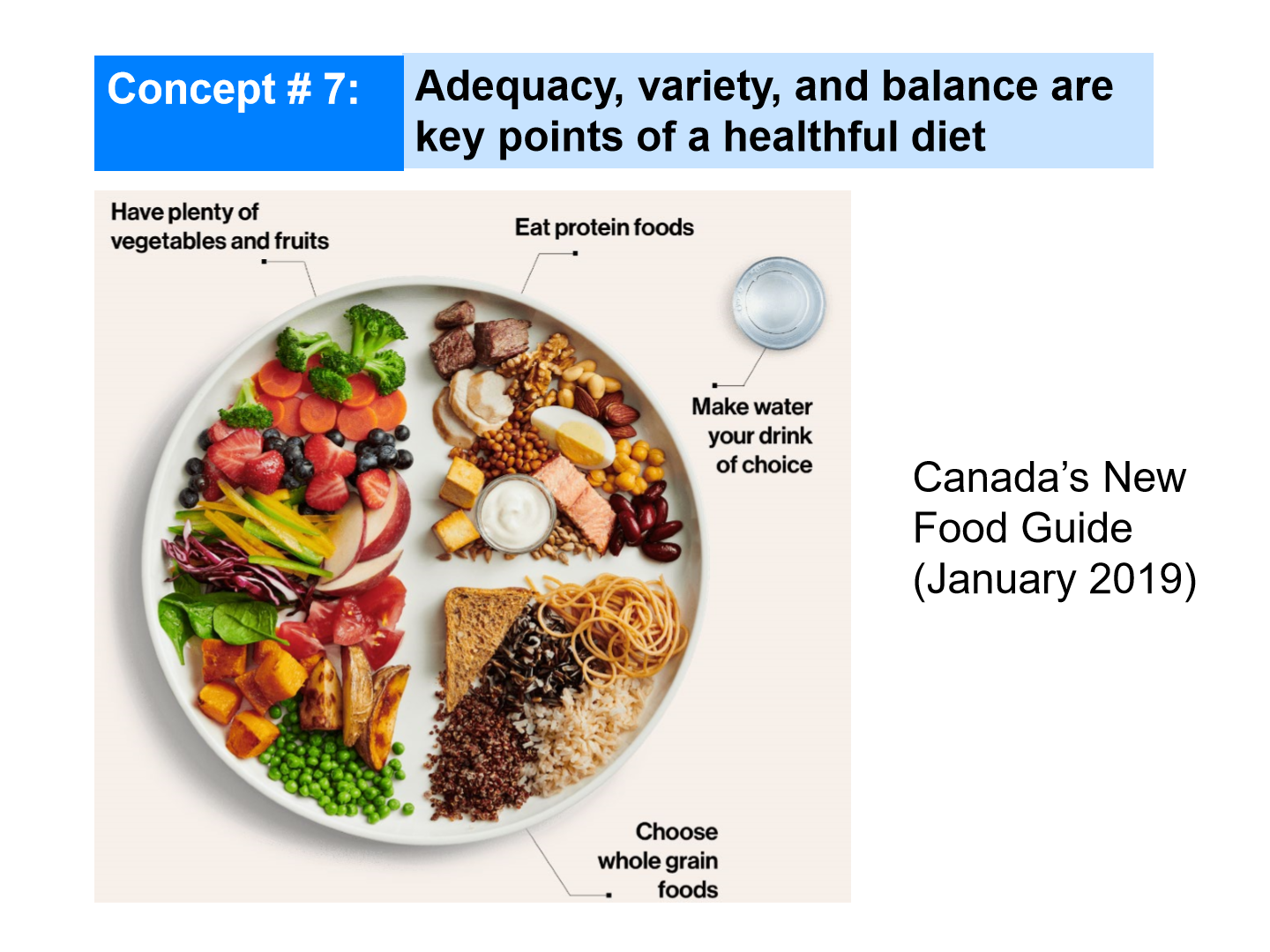
-
What are 3 key points of a healthy diet?
- adequacy
- variety
- balance
-
Are there good or bad foods?
NO!
-
Orthorexia nervosa
– Unhealthy fixation with eating healthy
– Can lead to nutritional deficits
– No specific category in DSM (Diagnostic & Statistical Manual) butfalls under Avoidant/Restrictive Food Intake Disorder (ARFID)
Questions to ask:
- Do you feel guilt or self-loathing when you stray from your diet?
- Are you constantly looking for ways foods are unhealthy for you?
- Do you feel in control when you stick to the “correct” diet?
- Have you put yourself on a nutritional pedestal and wonder how others can possibly eat the foods they eat?
- Does it seem beyond your ability to eat a meal prepared by someone else and not try to control what is served?
-
What are some conditions that contribute to death among adults under 75?
Health care: 10%
Environmental exposures: 20%
Lifestyles: 51%
Genetic makeup: 19%
-
Risk factors
A condition or behavior associated with an increased frequency of a disease but not proved to be causal.
-
What are some risk factors?
– Dietary
– Genetics
– Age
– Sedentary lifestyle
– Smoking and tobacco use
– Stress
– Environmental contaminants
-
What are the 3 highest mortality rates attributed to diet?
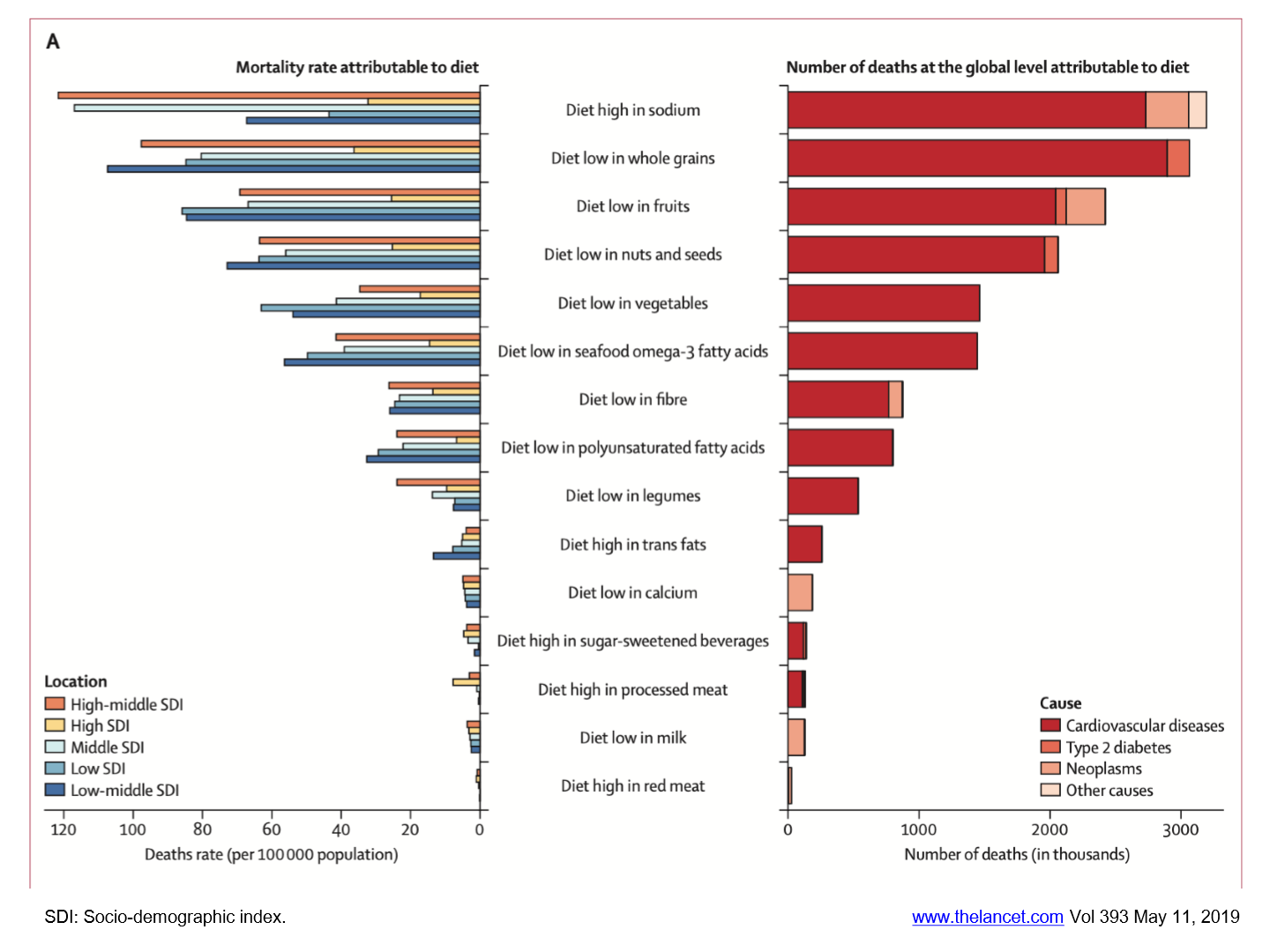
1. Diet high in sodium
2. Diet low in whole grains
3. Diet low in fruits
-
How do Western diets promote chronic diseases?
• Diets high in salt, refined grains (e.g. white flour), processed meats, refined sugars (e.g. white sugar)
• Diets low in fruits, vegetables and fiber
-
Top causes of death in the US
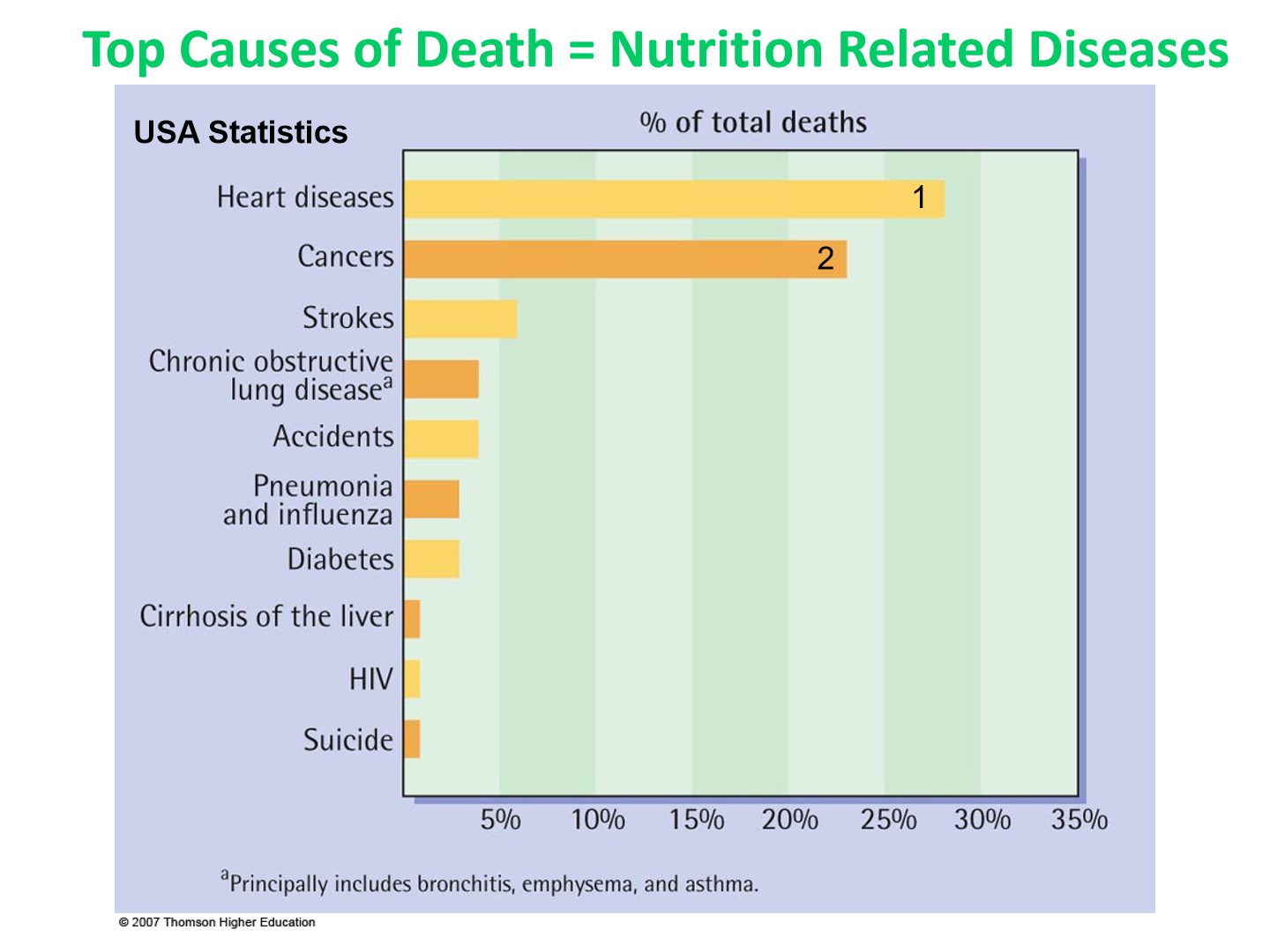
1. Heart disease
2. Cancers
3. Strokes
*nutrition related diseases
-
Leading death in Canada, 2019
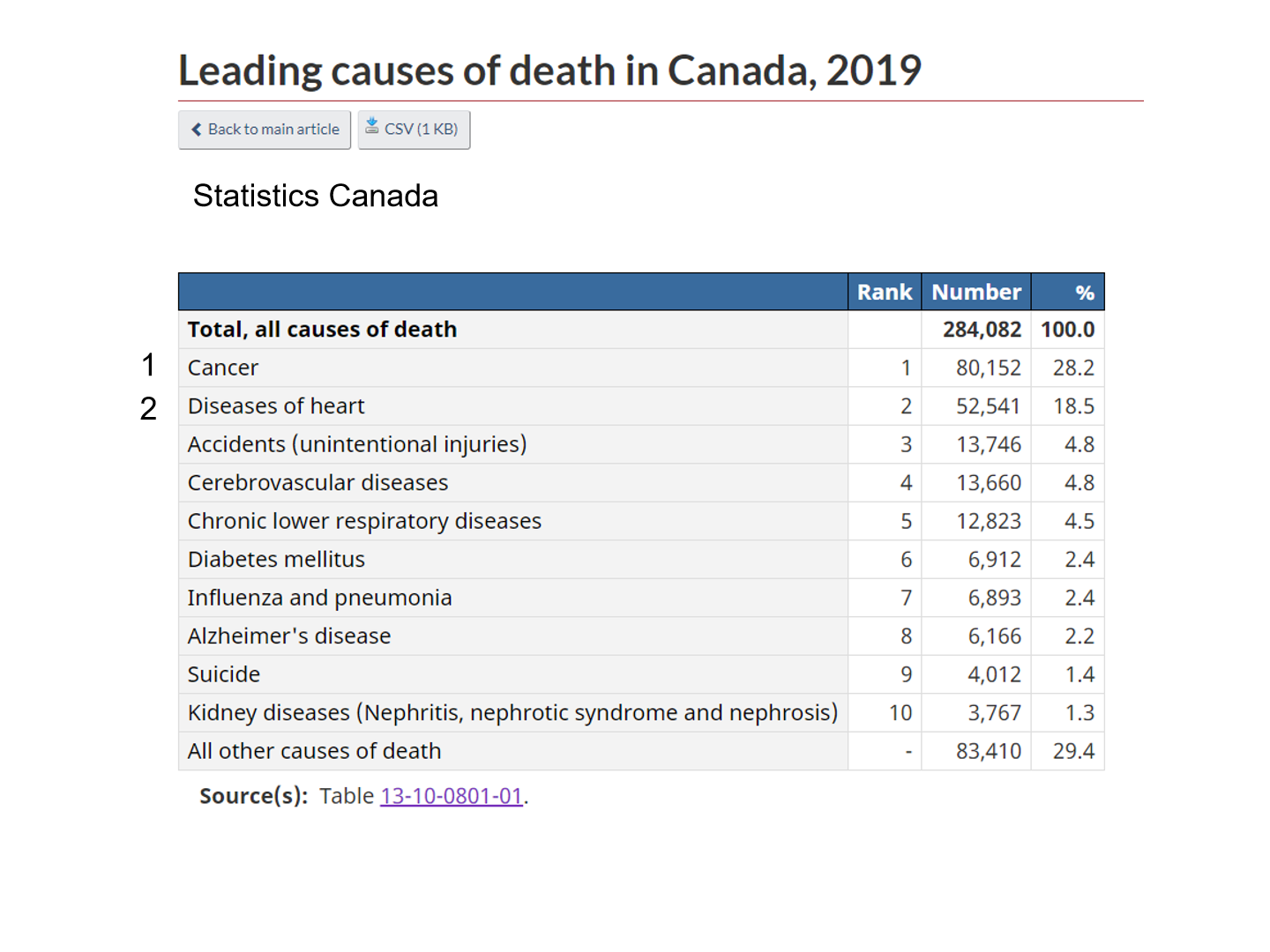
1. Cancer
2. Heart disease
3. Accidents
-
BMI (body mass index)

BMI = kg/(m)2
- <18.5 = at risk
- 18.5-24.9 = healthy
- 25-29.9 = overweight
- >30 = obesity
-
Obesity prevalence in Canadian adults
36.3% have overweight + 26.8% have obesity = 63.1% unhealthy weight
* greatest recent increase in obesity is in 20 to 39 yr olds
-
Obesity prevalence in Canadian children
17% have overweight + 9% have obesity = 26% unhealthy weight
-
Is obesity simply linked to calories?
NO! Obesity is a complex, multifactorial chronic disease. Calorie intake is just one contributor.
-
Are Ancient diets best?
• Some claim the healthiest diet is one that was eaten during the Paleolithic era 10,000 years ago.
• The Paleo diet restricts what you eat to foods the hunter-gathers of the Stone Age ate.
• They would overeat when food was available to protect them during famine.
• Very common to cycle through periods of feasting or famine
– “Feast or famine”
-
Feast and Famine then vs. now
Then: root vegetables (high in fibre), nuts, seeds, wild game
Now: too much choice contributes to overeating
-
What are some biological processes in the body that make it difficult to stay healthy in the current food environment?
• We get hungry every 4-6 hours even in the presence of excess body fat stores
– Today this can lead to consuming more calories than we burn
• Our bodies conserve sodium
– historically, diets were low in sodium and there was lots of vigorous activity, sweating, and diarrhea
– so it was advantageous to conserve sodium for survival.
– Today, this conservation of sodium in the context of a high sodium (salt) diet, leads to high blood pressure
-
Why do we naturally prefer fatty and sweet-tasting foods?
– sweet taste: we evolved to associate sweet taste with calories and nutrients that are safe for human consumption; help orient our behavior to seek out and consume these foods
– bitter: associated with toxic products (a lot of good vegetables taste bitter therefore people consume fewer)
– Today, we overconsume sugary foods and eat fewer vegetables
-
Were they healthier in the stone age?
– Many died of starvation
– Vitamin deficiencies & food poisoning
– Died younger so less degenerative disease
-
Should we eat like them?
Not necessarily...
– Meat differs (leaner back then)
– Fruits & vegetables differ (different types, nutrient levels may vary)
– Environment is different (more pollution, sedentary behaviour, etc.)
*Therefore, strive for more exercise & wholesome foods
-
What are some typical problems with sources of nutrition information?
– Tight deadlines
– Limited understanding
– Single study
– Report scientific findings prematurely
Half-truths and hype are common in books, newspapers, magazines, TV, radio, pamphlets, internet, speeches, etc.
– But we have the right to free speech...
-
Nutrition in media
• It is unlawful to state false claims on a product label or in an advertisement
• It is unlawful to use the U.S. or Canadian mail systems to send fraudulent products or receive payments for fraudulent products
*But rarely are these laws enforced, and penalties are minimal
-
What is the primary reason for nutrition misinformation?

Profit
• As long as people think there is a quick and easy way to lose weight, build muscle, slow aging and reduce stress, there will be a huge $$$ market for “nutritional” products and services
• The world market for vitamins alone is over $3 Billion!
-
Registered dietitian degree breakdown
* B.Sc. in nutrition
* Internship
* National licensing exam
* Registration (College of Dietitians of Alberta)
* RD
-
Nutritionist title
• Before September 2016 the title ‘Nutritionist’ could be used by anyone in Alberta to describe themselves as a professional in the Nutrition industry.
• As of September 2016, the title ‘Nutritionist’ can only be used by members of the College of Dietitians of Alberta.
– Registered Dietitian
- Registered Nutritionist
– RD
- Dietitian
– Nutritionist *
-
What are some sources of reliable nutrition information
• Health organizations (eg. Heart and Stroke Foundation; Canadian Diabetes Association)
• Scientific organizations (eg. Canadian Nutrition Society)
• Professional organizations (eg. Dietitians of Canada)
• Government publications (eg. Health Canada)
• Registered, licensed or certified dietitians
• Nutrition textbooks (not diet best sellers)
-
What is the importance of nutrition research?
• Facts and evidence provided by scientific studies: used to develop nutrition information and guidelines that affect public’s health.
• Peer-reviewed papers published in scientific journals.
-
Ways to identify nutrition quackery
1. Too good to be true or a quick fix
2. Testimonials (before and after pictures)
3. Make you suspicious of food supply
4. Fake credentials
5. Elimination of whole food groups
6. Use of the word ‘natural’
7. Supplements needed by all; megadoses
-
Gut-brain connection
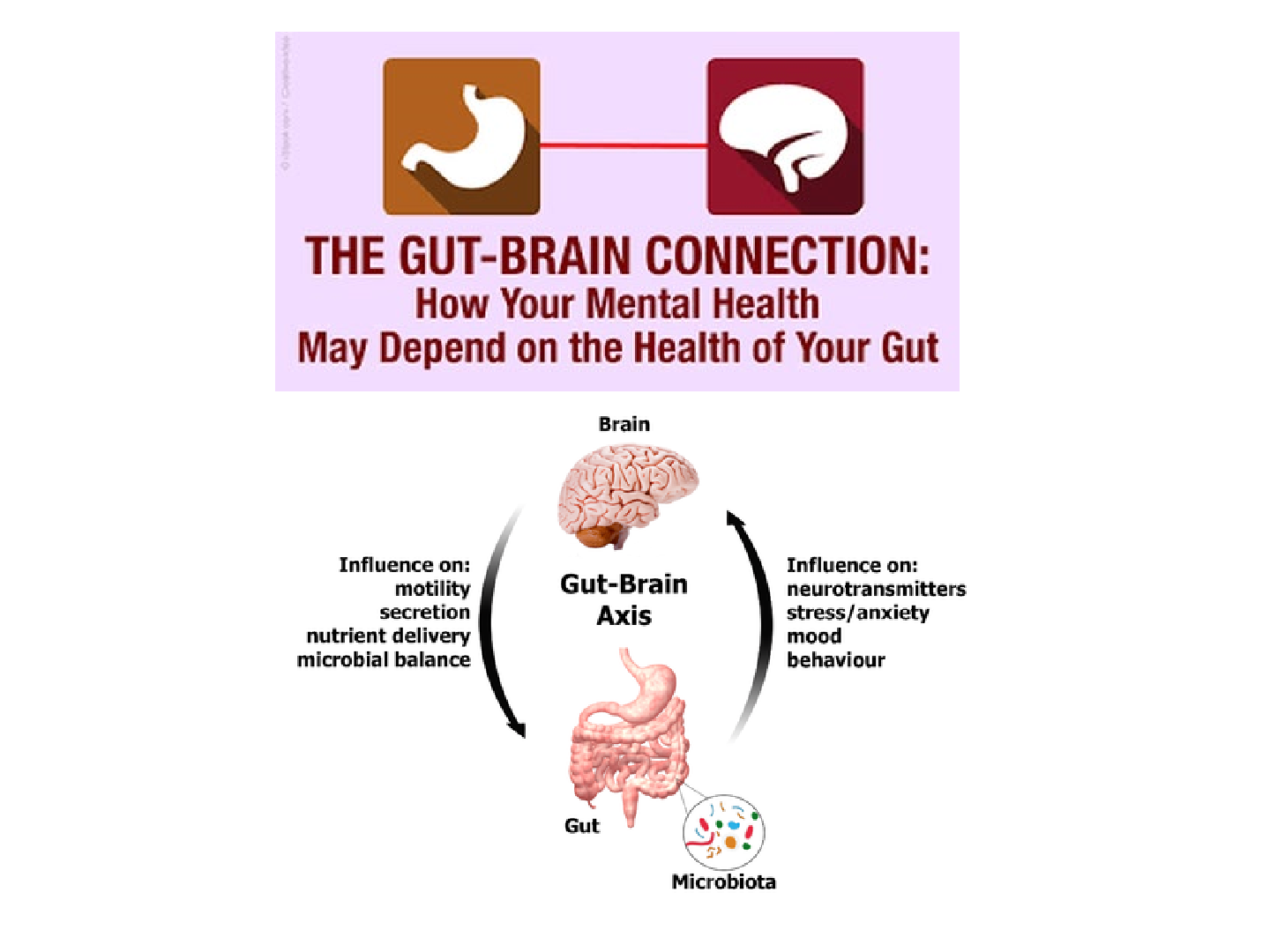
Implies that there is a connection between gut microbiota and stress/mood.
*Probiotics may improve psychological symptoms associated particularly with anxiety
-
What foods must be labeled?
• Foods containing more than one ingredient (mostly processed foods)
• Dietary supplements
• If a claim is made - “low fat,” “low calorie,” etc. - must display nutrition information backing the claim
-
What dietary claims have guidelines vs which don't?
– Light: no guidelines
– Low sugar: no guidelines
– Reduced fat or calories: 25% less than the original
– Fat free: <0.5g
-
Foods that are not required to be labeled
• fresh fruits and vegetables
• raw, single-ingredient meat, poultry, fish and seafood
• very small packages, such as one-bite candy
• items with insignificant calories and nutrients, such as herbs and spices
• food sold at farmer's markets
• food sold only in grocery stores where the product is prepared or packaged in-store (e.g. bakery, salads)
• alcoholic beverages
-
Organic foods
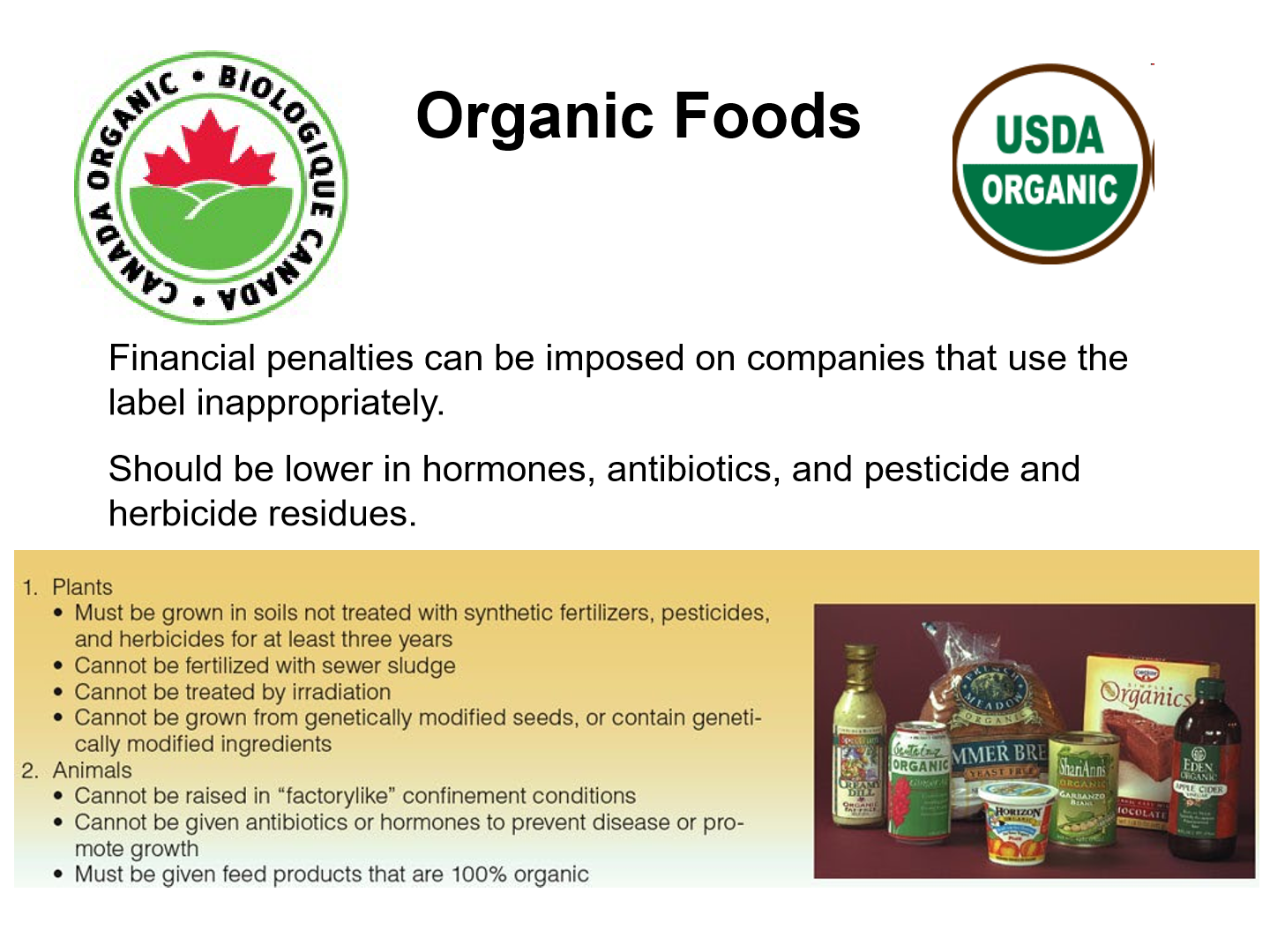
Should be lower in hormones, antibiotics, and pesticide and herbicide residues.
-
Animals and Plants organic outlines
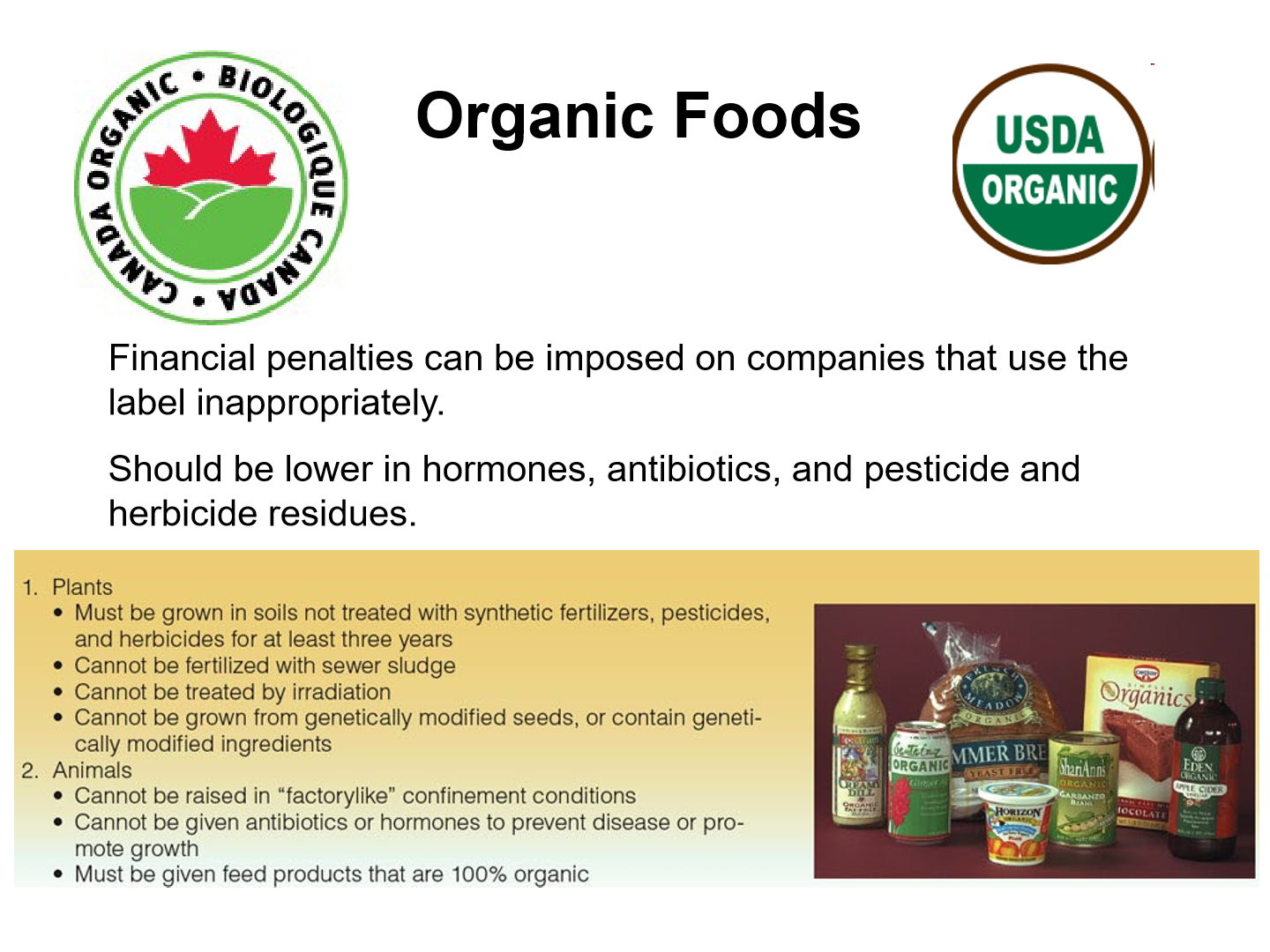
-
Regulated by the Canadian Food Inspection Agency
1. Only products with organic content of ____ can be labelled as organic.
A. >50%
B. >70%
C. ≥95%
C
-
2. ‘Organically grown’, ‘organically raised’ or ‘organically produced’ all mean the same as organic and meet the same requirements.
A. True
B. False
A
-
If a multi-ingredient product has 70 to <95% organic content:
• Must declare the percentage of organic content on the label
• May NOT use the organic logo nor the claim organic
• If <70% organic content, can only indicate which ingredients are organic in the ingredient list
-
Is organic food healthier than non-organic?
Nutrient-wise (protein/vitamins/etc.) they are similar. One difference is that organic fruits & vegetables can have higher antioxidant content. Organic diets do lead to less pesticide exposure.
-
What food is a better investment buying organic?
• Avocados, cantaloupe, pineapple, broccoli, cabbage and corn have low levels of pesticides, so less advantage to buying organic.
• Strawberries, spinach, grapes, apples, tomatoes and celery have higher levels of pesticide residues.
-
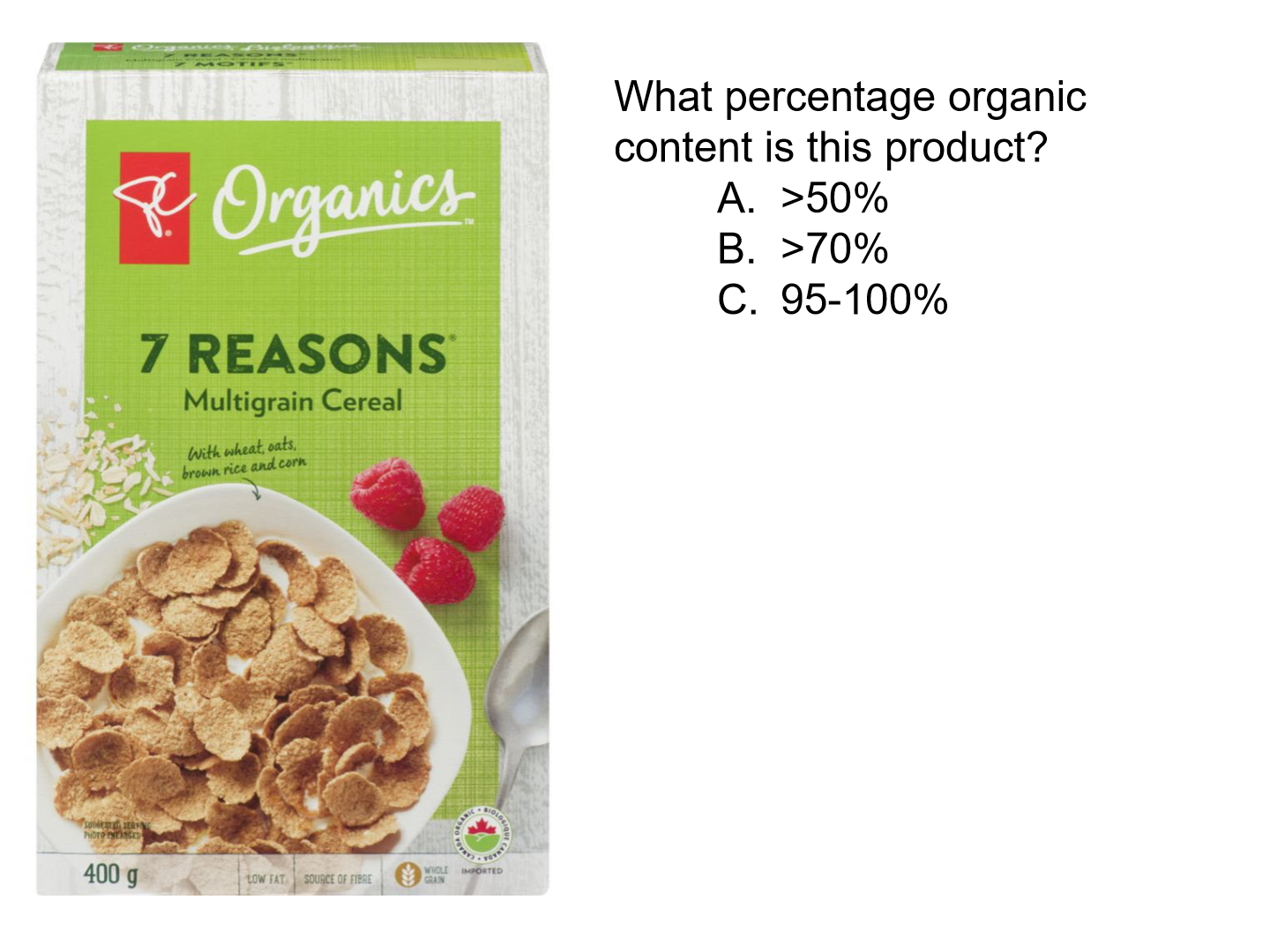
C
- it has the Canadian organic logo
-
Health claims on food
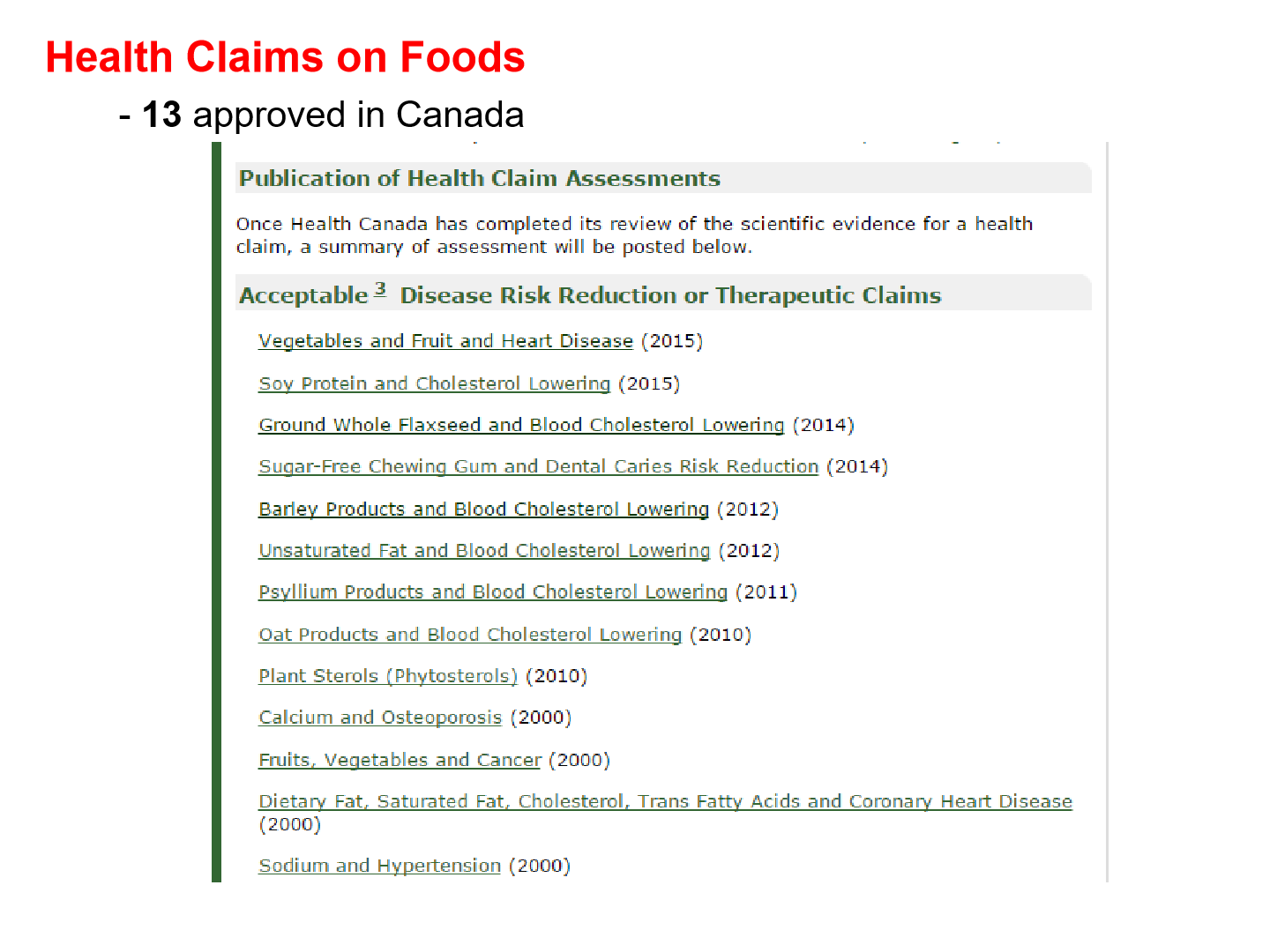
There are 13 approved in Canada
-
Enrichment
pertains only to refined grain products where thiamin, riboflavin, niacin, and iron lost in milling are added
– Producers of bread, cornmeal, pasta and crackers from refined grains must use enriched flours
-
Fortification
the addition of a vitamin or mineral not normally found in the food
-
Rules of the ingredient label (2)
• All ingredients must be listed in descending order of amount present (by weight)
• Ingredients causing allergic reactions (peanuts, tree nuts, milk, eggs, fish, shellfish, wheat, soy, sesame and sulphites) must also be listed on the ingredient label
-
Do food additives need to be on the label?
YES!
• Food additives must be listed
• 3000 chemicals are added to food to enhance its flavor, color, texture, cooking properties, shelf life, or nutrient content
• Food additives with “GRAS” can be used without pre-approval (Generally Recognized As Safe)– Sodium chloride, sucrose, cornstarch, many vitamins/minerals
• New additives must be approved by Health Canada prior to use
-
Irradiated foods
1. Must contain radura symbol
2. Uses:
- Prevent sprouting
- Delay ripening
- Kill insects/mold/bacteria
- Potatoes, onions, wheat, flour, spices, ground beef
3. Foods do not retain radioactive particles
4. Doses: 10-20X higher than lethal dose in humans
-
Dietary supplement labeling
• Dietary supplements must be labeled
• Dietary supplement labels cannot claim the products treat, cure, or prevent disease
• Not classified as a drug, so no vigorous testing
*must have a product license
-
Do we have an innate nutrient drive?
NO!
• We don’t generally seek out nutrients we are deficient in
• Select food based on food preferences, culture, nutrition knowledge & beliefs, cost, hunger, availability, convenience
• Humans and most animals will seek water and food, but not generally the best foods, unless they have learned how to eat a well-balanced die
-
How Do We Decide When and How Much to Eat?
• Hunger, satiety and thirst centers are located in the “primitive” brain
– Hypothalamus – appetite centre
• Inborn attraction to sweet and salty tasting foods, dislike of bitter and sour foods
-
Do infants also prefer sweet food?
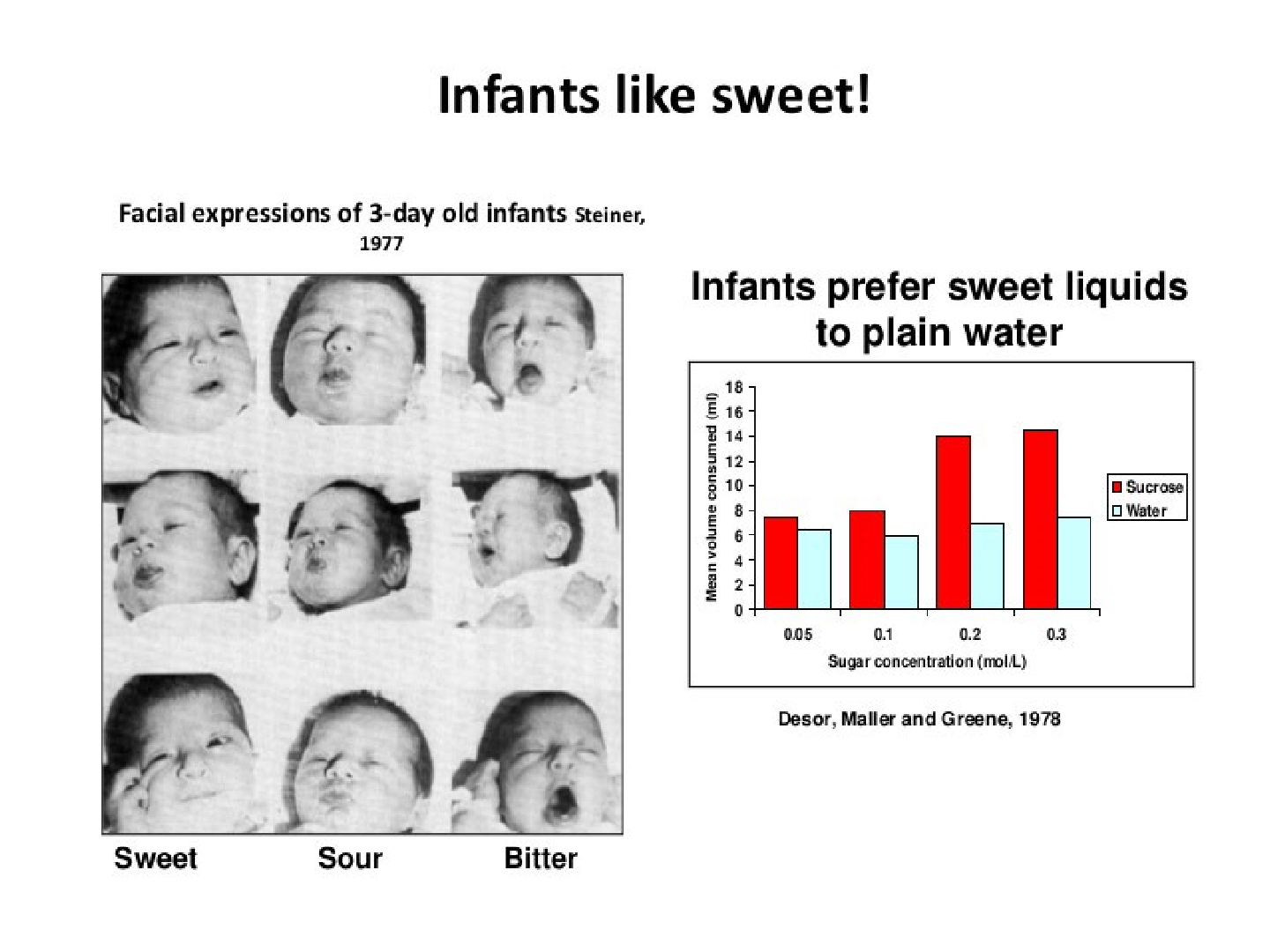
YES!
-
What Makes Us “Like” or “Dislike?”
• The strongest influence is “food preference,” a learned behavior
• Food preference is shaped by memory and memories are based on culture and the pleasure associated with the memory
• We reject foods that bring us discomfort, guilt and unpleasant memories (e.g. eating something that gave us food poisoning; as a child having to eat vegetables before leaving the table)
-
How does food marketing influence what we eat?
• Food marketing can influence food choices. It is designed to:
– create food trends
– encourage you to:
• buy certain foods or drinks
• buy foods in order to get promotional items such as:
– loyalty points
– tickets to movies or sports events
– coupons for future food purchases
– create links between certain foods or brands and a particular lifestyle
– build brand loyalty so you will continue to purchase from a particular store or products with a brand name
-
Red and food
enhances appetite; increases heart rate
-
Green
healthy; eco-friendly; natural
-
White
reduced calories
-
Yellow
happiness & youthfulness; brain processes yellow very rapidly
-
Orange
good value; stimulates appetite and conversation
-
Brown
rich flavour
-
Blue
suppress appetite; most unappetizing color (only really in children food)
-
What makes an adequate diet?
• Variety of foods provide sufficient levels of calories and essential nutrients
• An adequate diet contains all nutrients necessary for long-term survival but it may not necessarily be optimal or have any variety.
-
What makes a balanced diet?
• Provide calories, nutrients, and other components in the right proportions
• A balanced diet has the six classes of nutrients in good proportion
-
Essential nutrients
Nutrients the body cannot produce, or produce in sufficient amounts; must be obtained in the diet– Example: Iron, calcium
-
Nonessential nutrients
Nutrients the body can manufacture in sufficient quantities– Example: Cholesterol
-
Recommended nutrient intake of carbohydrates, fat, protein and fiber
Carbohydrates: 45-65%
Fat: 20-35%
Protein: 10-35%
Fiber: 25g-38g
-
Why is the western diet bad?
• Western diet overloaded with
– Refined sugars
– Saturated fats
– Salt
• Low in
– Essential fatty acids
– Dairy products
– Vegetables and fruits
– Fiber
• High intakes of fat (saturated fat and trans fat) are risks for heart disease and metabolic syndrome
• Low intake of dairy products and vitamin D are risks for osteoporosis
-
Western diet with vegetables and whole grains
• Only 6% of adults regularly consume broccoli, cauliflower, Brussels sprouts, or dark, leafy green vegetables– These are associated with reduced cancer risk– Most commonly consumed vegetable in the U.S. is the potato
• More whole grains are needed– Whole grains reduce the risk of certain types of cancer, type 2 diabetes and heart disease
• Americans consume an average of one serving of whole-grain products daily
-
What are some different guides to healthy diets?
• Canada’s Food Guide (HC)
• MyPlate (USDA)
• Mediterranean Food Pyramid (WHO)
-
What were the 4 food groups in the previous food guide?
1. Grain products
2. Vegetables and fruit
3. Milk products
4. Meat and alternatives
-
Does the new food guide use food groups?
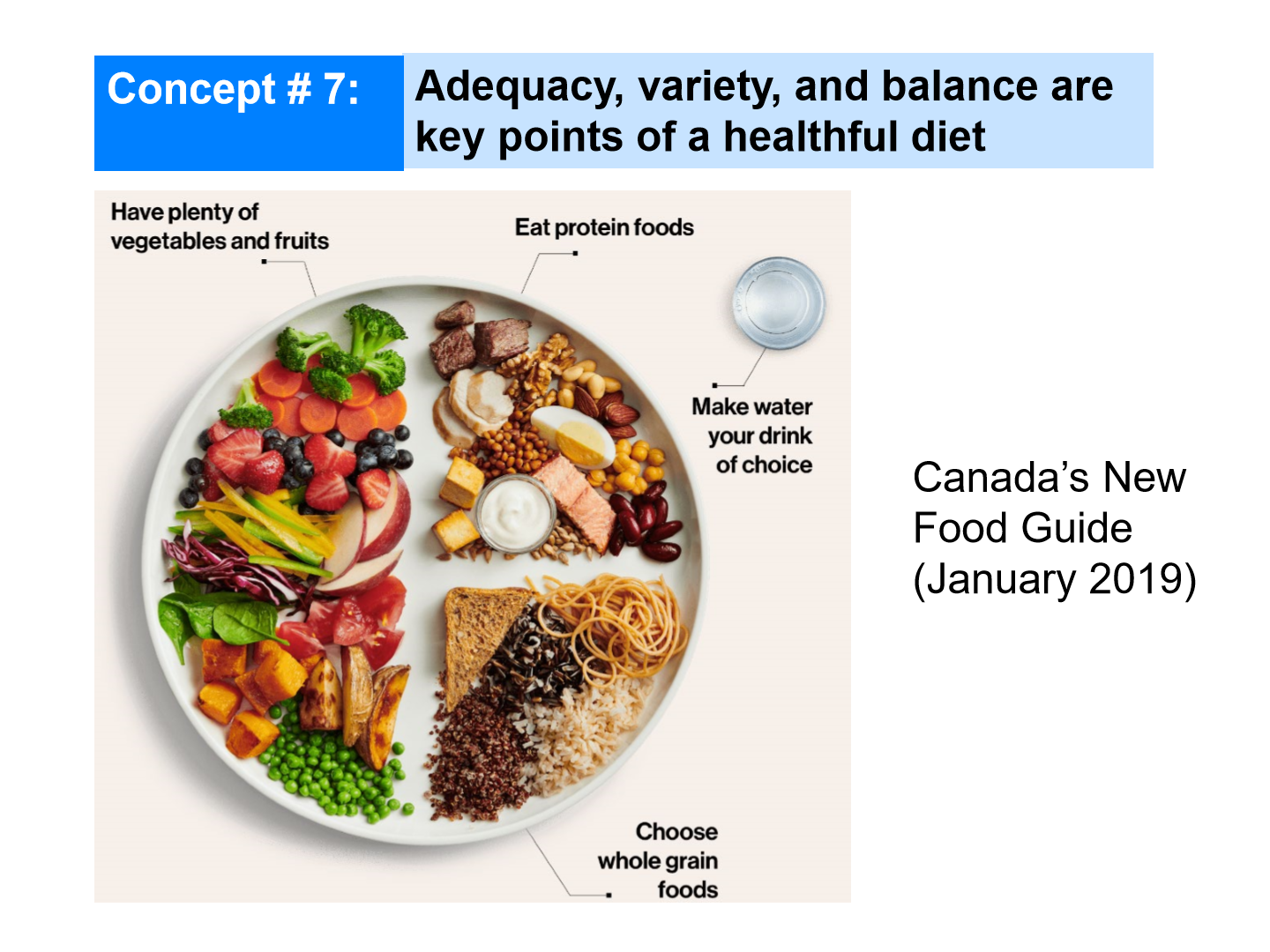
Not really
- The new Food Guide focuses on broader statements and no longer uses the food group categories.
-
USDA MyPlate guides
Grains: Make half your grains whole grains.
Protein: Vary your proteins.
Vegetables: Make half your plate fruits and vegetables; vary your vegetables.
Fruits: Make half your plate fruits and vegetables; focus on whole fruits.
Dairy: Move to low-fat or fat-free dairy milk or yogurt.
-
Mediterranean Diet Pyramid
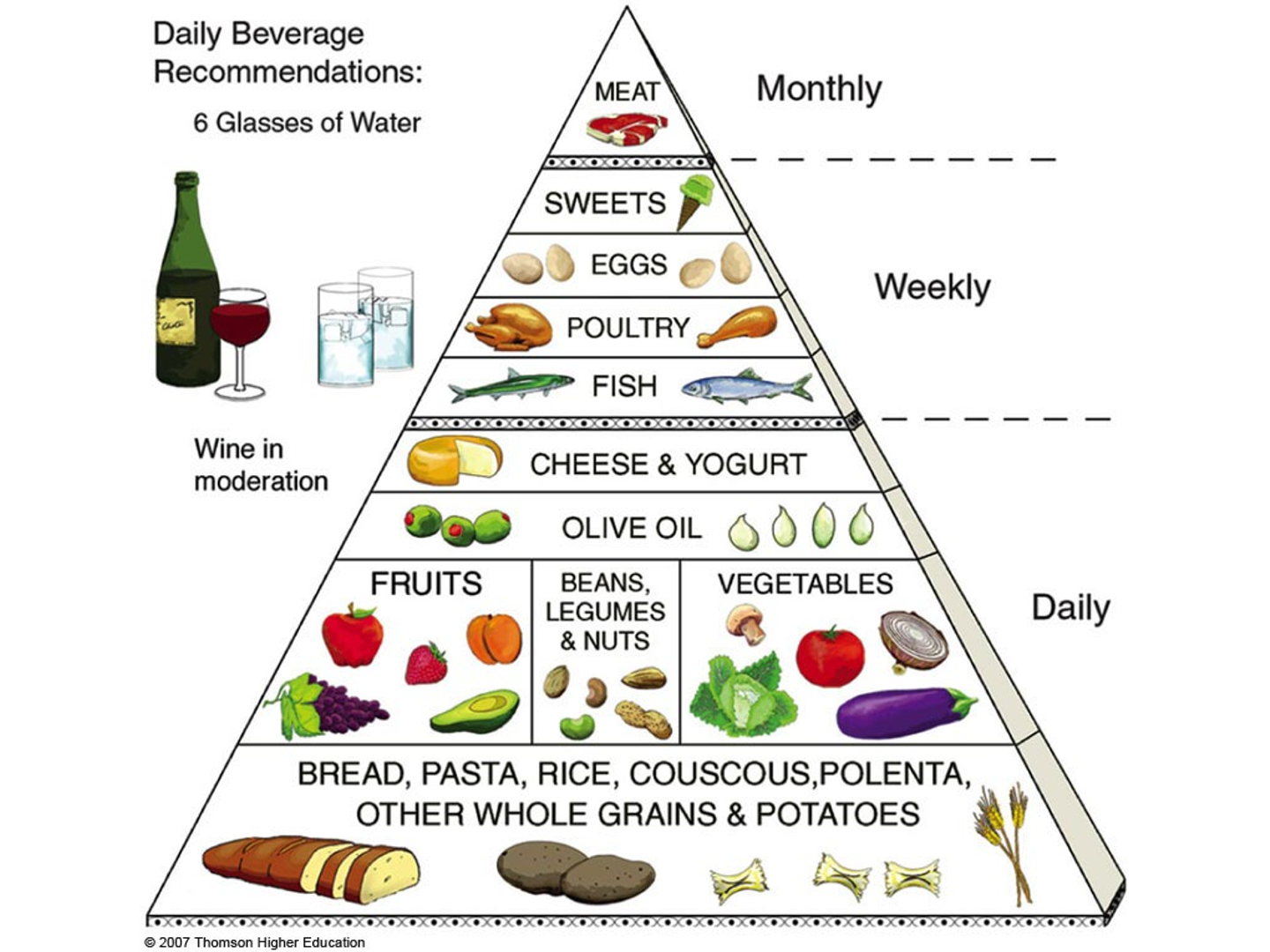
• WHO developed guide in 1994 to help popularize a diet associated with reduced risk of heart disease and cancer
• Emphasizes olive oil, breads, whole-grain cereals, nuts, fish, dried beans, vegetables, and fruits; and wine in moderation
• Intake of red meats is limited to monthly, and sweets and poultry to weekly intake
• Key features: rich in plant foods, olive oil, limited red meat
-
The gut and nutrition
The Gut
• Approximately 92 - 99% of the protein, fat and carbohydrate that we consume is digested and absorbed
• Most of the dietary fiber is not digested
– Most is fermented by bacteria
-
Mechanical digestion
• Physical breakdown of food
• Chewing, grinding and mixing food with mouth, tongue and teeth
-
Chemical digestion
• Chemical breakdown of food using enzymes, bile and hydrochloric acid
• There are over 100 enzymes that are secreted by the digestive system
-
The digestive system is made up of the following:
- Mouth- Pharynx- Epiglottis- Esophagus- Stomach- Small intestine- Large intestine- Rectum- Anus
-
Accessory organs to the digestive system
- Liver- Gall bladder- Pancreas
-
Heartburn
• Caused by excessive stomach acid or defective lower esophageal sphincter
– causes burning sensation in the esophagus.
• Acid reflux is a common medical condition that can range in severity from mild to serious. Gastroesophageal reflux disease (GERD) is the chronic, more severe form of acid reflux. Heartburn is a symptom of acid reflux and GERD.
• Stress, anxiety, frequent use of aspirin and other anti-inflammatory medicines, fatty foods, spicy foods, coffee, alcohol, citrus fruits, soft drinks, and other foods are involved
• Weight gain and eating within 3 hours prior to going to bed increase symptoms
– weight gain of 10-20 pounds associated with a 3-fold increase in heartburn symptoms
-
How to help heartburn
• High-fiber diets protect against development of heartburn
• Treatments include
– stress reduction
– elimination of offending foods
– eating small, frequent meals
– mild occasional heartburn can use over-the-counter antacids but with persistent symptoms, prescription medication may be needed (e.g. H2 blockers, proton pump inhibitor)

